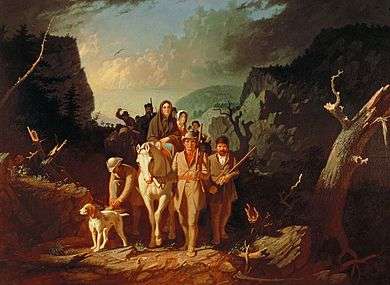Cumberland Gap, Tennessee
| Cumberland Gap, Tennessee | |
|---|---|
| Town | |
|
Colwyn Avenue in Cumberland Gap | |
|
Location of Cumberland Gap, Tennessee | |
| Coordinates: 36°35′56″N 83°40′2″W / 36.59889°N 83.66722°WCoordinates: 36°35′56″N 83°40′2″W / 36.59889°N 83.66722°W | |
| Country | United States |
| State | Tennessee |
| County | Claiborne |
| Area | |
| • Total | 0.3 sq mi (0.8 km2) |
| • Land | 0.3 sq mi (0.8 km2) |
| • Water | 0.0 sq mi (0.0 km2) |
| Elevation | 1,299 ft (396 m) |
| Population (2010) | |
| • Total | 494 |
| • Density | 1,600/sq mi (620/km2) |
| Time zone | Eastern (EST) (UTC-5) |
| • Summer (DST) | EDT (UTC-4) |
| ZIP codes | 37724, 37752 |
| Area code(s) | 423 |
| FIPS code | 47-18880[1] |
| GNIS feature ID | 1281829[2] |
| Website |
www |
Cumberland Gap is a town in Claiborne County, Tennessee, United States. Its population was 494 at the 2010 census.[3] The town is located near the Cumberland Gap, a historic mountain pass for which the town is named, and is surrounded on all sides by the Cumberland Gap National Historical Park. The town is also a part of the park.
Most of the downtown area is listed on the National Register of Historic Places as Cumberland Gap Historic District.

History
In 1888, a work camp was established at Cumberland Gap by Scottish-born entrepreneur Alexander Arthur (1846–1912) to house workers needed to build a tunnel for the Knoxville, Cumberland Gap & Louisville Railroad. Arthur, who was attempting to establish a large-scale iron production operation in the Cumberland Gap region, founded the nearby cities of Middlesboro, Kentucky, and Harrogate, Tennessee, and the nearby community of Arthur.[4]
Geography
Cumberland Gap is located at 36°35′56″N 83°40′2″W / 36.59889°N 83.66722°W (36.598976, -83.667318).[5]
According to the United States Census Bureau, the town has a total area of 0.3 square miles (0.78 km2), all land.
Demographics
| Historical population | |||
|---|---|---|---|
| Census | Pop. | %± | |
| 1910 | 347 | — | |
| 1920 | 304 | −12.4% | |
| 1930 | 369 | 21.4% | |
| 1940 | 409 | 10.8% | |
| 1950 | 403 | −1.5% | |
| 1960 | 291 | −27.8% | |
| 1970 | 231 | −20.6% | |
| 1980 | 263 | 13.9% | |
| 1990 | 210 | −20.2% | |
| 2000 | 204 | −2.9% | |
| 2010 | 494 | 142.2% | |
| Est. 2015 | 492 | [6] | −0.4% |
| Sources:[7][8] | |||
As of the census[1] of 2000, there were 204 people, 89 households, and 51 families residing in the town. The population density was 629.9 people per square mile (246.1/km²). There were 111 housing units at an average density of 342.8 per square mile (133.9/km²). The racial makeup of the town was 99.02% White and 0.98% Native American.
There were 89 households out of which 25.8% had children under the age of 18 living with them, 47.2% were married couples living together, 6.7% had a female householder with no husband present, and 41.6% were nonfamilies. 34.8% of all households were made up of individuals and 15.7% had someone living alone who was 65 years of age or older. The average household size was 2.29 and the average family size was 3.06.
In the town the population was spread out with 21.1% under the age of 18, 10.3% from 18 to 24, 30.9% from 25 to 44, 23.0% from 45 to 64, and 14.7% who were 65 years of age or older. The median age was 37 years. For every 100 females there were 90.7 males. For every 100 females age 18 and over, there were 83.0 males.
The median income for a household in the town was $36,250, and the median income for a family was $40,625. Males had a median income of $36,250 versus $17,083 for females. The per capita income for the town was $12,005. About 9.3% of families and 23.3% of the population were below the poverty line, including 26.7% of those under the age of 18 and 28.6% of those 65 or over.
Education
There are no schools in the town limits, but Cumberland Gap High School located southwest of Harrogate, Tennessee, is in Cumberland Gap's 37724 zip code.
Lincoln Memorial University is located in nearby Harrogate.
Notable person
- Rodney Atkins - country singer with five number one singles
References
- 1 2 "American FactFinder". United States Census Bureau. Archived from the original on 2013-09-11. Retrieved 2008-01-31.
- ↑ "US Board on Geographic Names". United States Geological Survey. 2007-10-25. Retrieved 2008-01-31.
- ↑ Tennessee Department of Economic and Community Development, Certified Population of Tennessee Incorporated Municipalities and Counties, State of Tennessee official website, 14 July 2011. Retrieved: 6 December 2013.
- ↑ Carolyn Sakowski, Touring the East Tennessee Backroads (Winston-Salem: J.F. Blair, 1993), pp. 178–179.
- ↑ "US Gazetteer files: 2010, 2000, and 1990". United States Census Bureau. 2011-02-12. Retrieved 2011-04-23.
- ↑ "Annual Estimates of the Resident Population for Incorporated Places: April 1, 2010 to July 1, 2015". Retrieved July 2, 2016.
- ↑ "Census of Population and Housing: Decennial Censuses". United States Census Bureau. Retrieved 2012-03-04.
- ↑ "Incorporated Places and Minor Civil Divisions Datasets: Subcounty Resident Population Estimates: April 1, 2010 to July 1, 2012". Population Estimates. U.S. Census Bureau. Archived from the original on 17 June 2013. Retrieved 11 December 2013.
